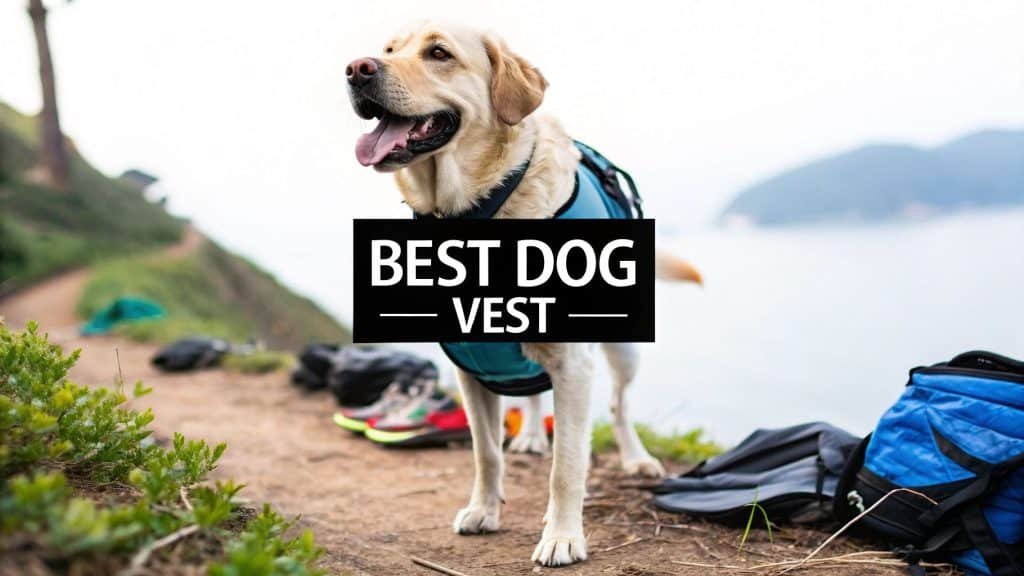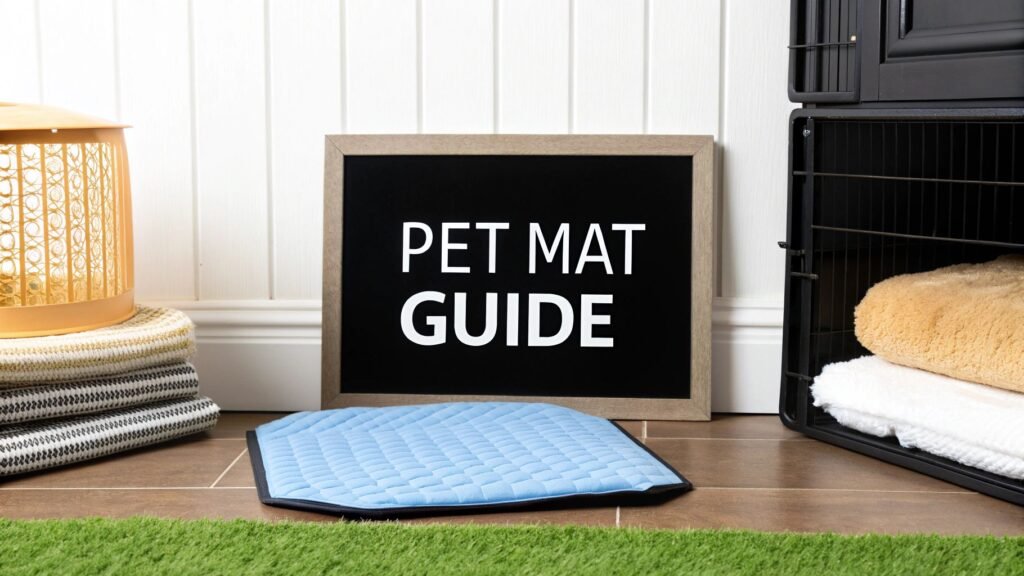Dog Measurements for Harness a Perfect Fit Guide
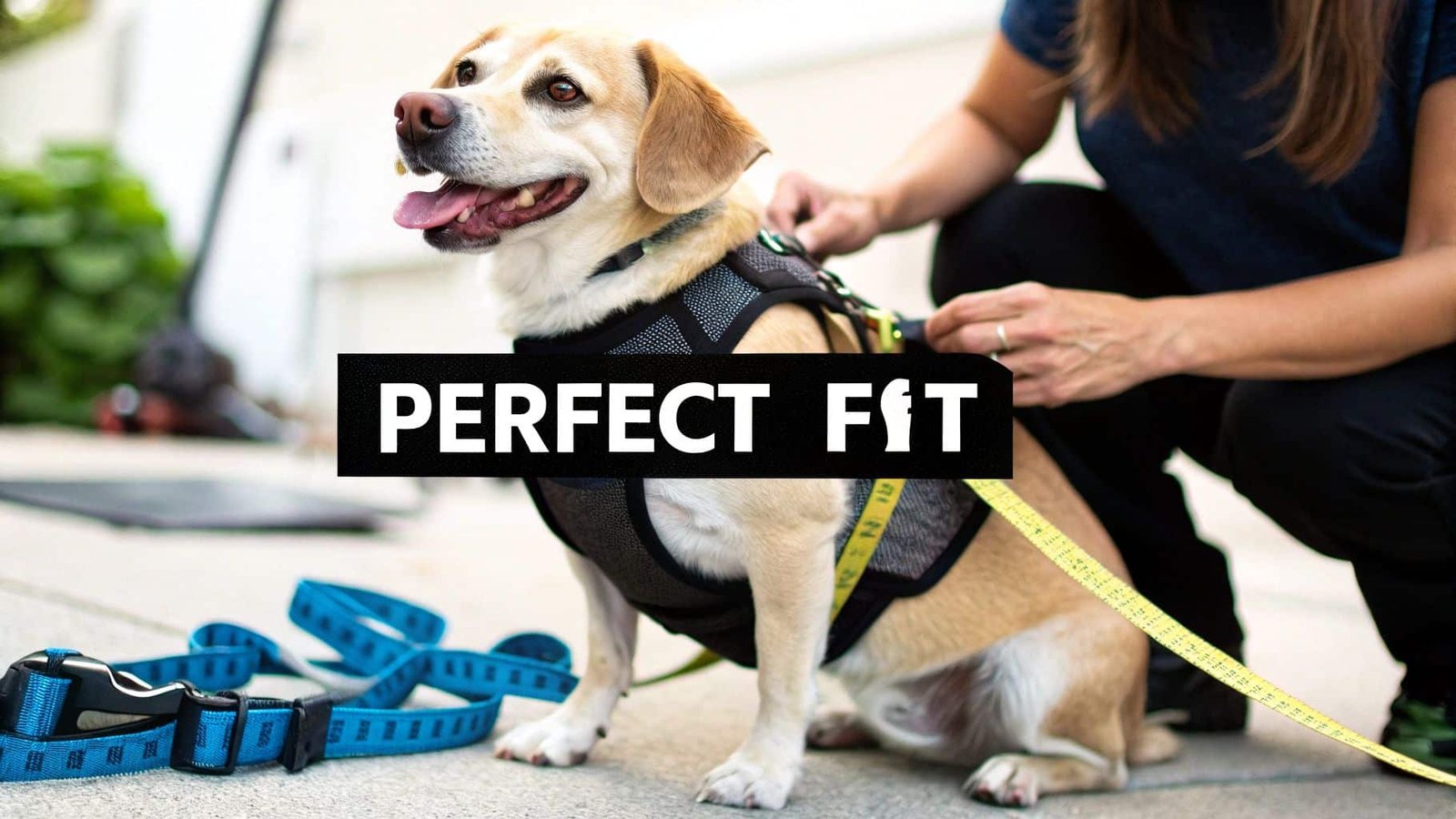
Getting the right dog measurements for a harness is the single most important thing you can do to keep your dog safe and comfortable on walks. I’ve seen it firsthand—an ill-fitting harness can cause everything from painful chafing and restricted movement to a terrifying escape. It can quickly turn what should be a fun outing into a stressful mess for both of you.
Why Accurate Harness Measurements Are a Game-Changer
Before you even reach for the measuring tape, let’s talk about why getting this right is so critical. A harness isn’t just another cute accessory; it’s a piece of safety gear. It’s specifically designed to spread pressure across the strongest parts of your dog’s body, like their chest and back, which protects their delicate throat from the strain a regular collar can cause.
This move toward harnesses is a big deal in the pet world. The global dog harness market was valued at around USD 5.53 billion in 2024 and is only expected to climb. That’s not just because more people have dogs—it shows a real shift in how we think about our pets’ well-being. You can learn more about the dog harness market growth to see just how much consumer priorities have changed.
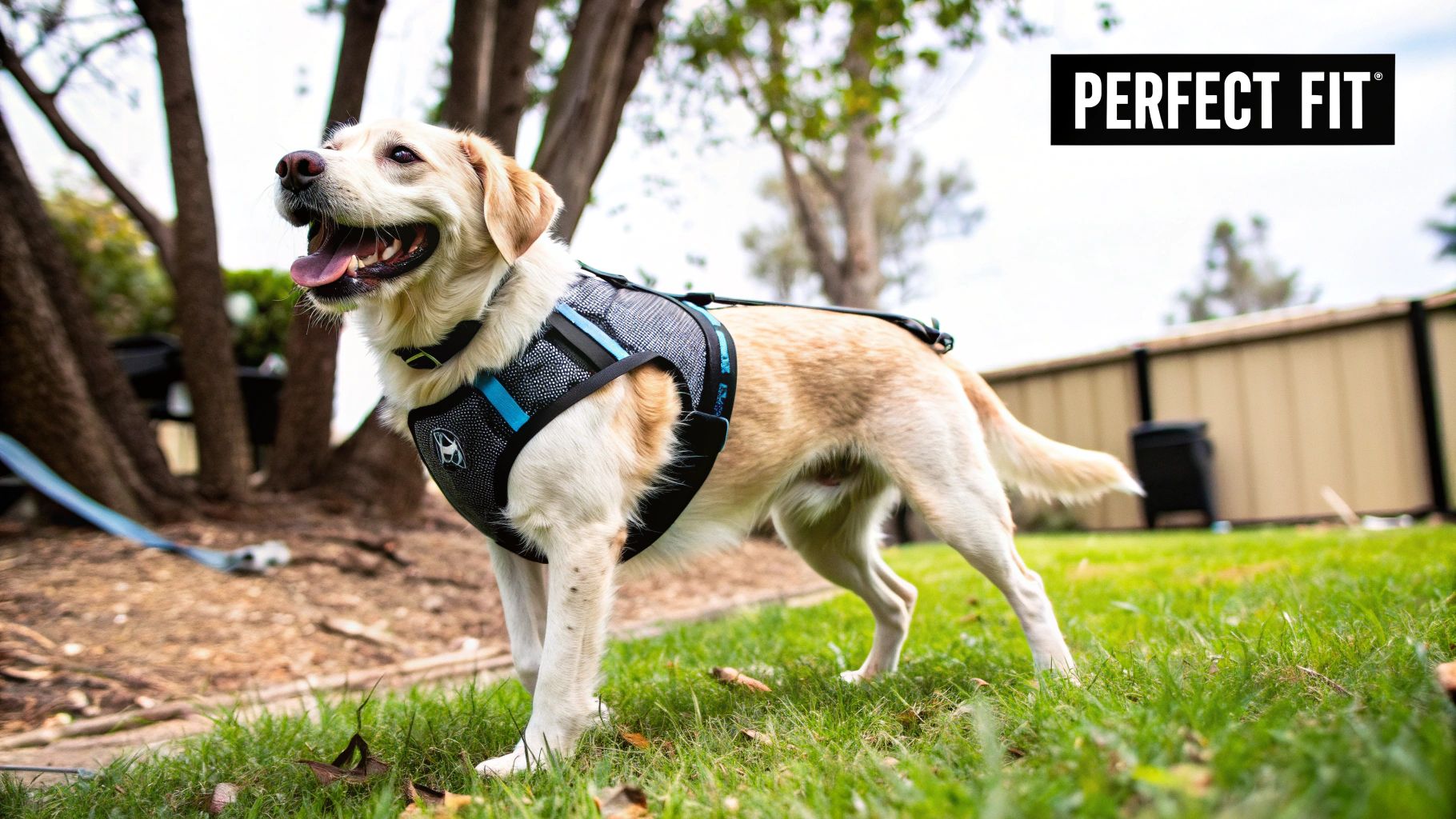
The Dangers of a Poor Fit
When a harness doesn’t fit correctly, it can create a laundry list of problems, ranging from minor annoyances to serious health concerns. A harness that’s too tight, for example, can dig into their skin and restrict the natural movement of their shoulders, potentially causing gait problems down the line.
On the flip side, a harness that’s too loose is an escape artist’s dream. A nervous or overly excited dog can wiggle out in seconds, putting them in immediate danger, especially if you’re anywhere near a busy road.
A proper fit is non-negotiable. It ensures the harness does its job: providing gentle guidance and secure control without causing pain or limiting your dog’s ability to move freely. It’s the foundation for every safe and happy walk you’ll take together.
The Payoff: Benefits of a Perfectly Sized Harness
Spending a few extra minutes to get those measurements right pays off in big ways. A well-fitted harness delivers on multiple fronts:
- Real Safety: It stops your dog from backing out and slipping free, even if they get spooked.
- All-Day Comfort: No more painful rubbing under the front legs or chafing across the chest.
- Effortless Control: You can guide your dog more effectively and gently, without yanking on their neck.
- Long-Term Health: It supports healthy shoulder and muscle function by allowing a full, natural range of motion.
Getting Set Up for a Smooth Measurement Session
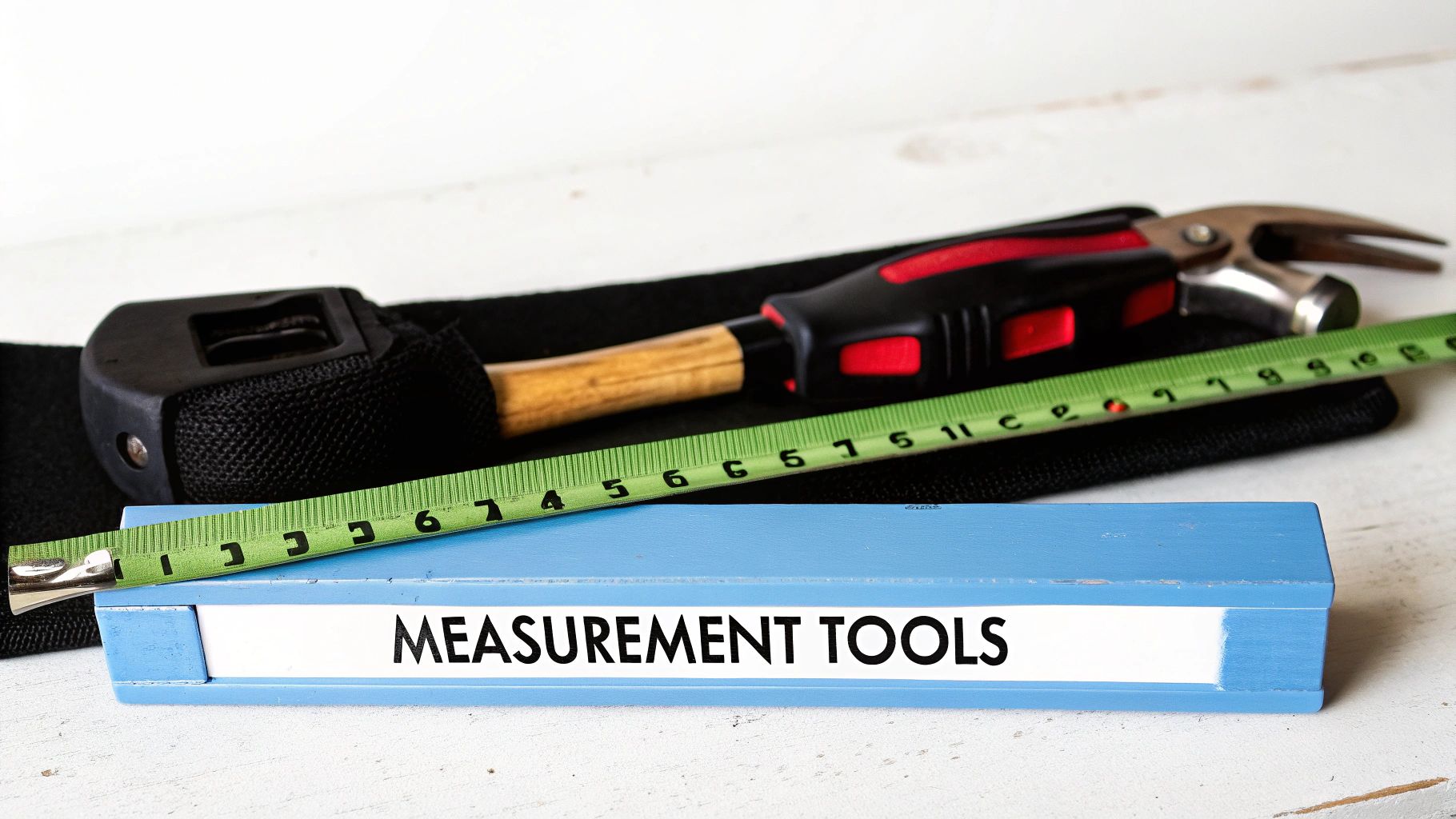
Getting the right fit for a harness begins well before you even unroll the measuring tape. The real secret is turning what could be a stressful moment into a positive experience for your dog. I always tell people to think of it as a fun training game, not a chore.
First, let’s talk tools. The best thing to use is a soft, flexible measuring tape—the kind you’d find in a sewing kit. A rigid metal tape measure from the garage just won’t work; it can’t curve around your dog’s body, so your numbers will be way off.
No soft tape? No problem. A piece of string or even a phone charging cable works just as well in a pinch. Simply wrap it around your dog, pinch the spot where it meets, and then measure that length against a ruler or yardstick.
Keep Things Calm and Positive
Your dog is an expert at reading your mood, so if you’re relaxed, they’re more likely to be. Pick a time when your dog is already chill, maybe after a nap, not when they’re bouncing off the walls waiting for a walk. And definitely have some of their favorite high-value treats on hand.
The whole idea here is positive reinforcement. Offer a treat just for letting you get close with the measuring tape. Give them another for allowing you to gently drape it over their back. You’re building a good association with being handled this way.
A calm dog is a cooperative dog. By using treats and patience, you’re not just getting measurements; you’re reinforcing trust and making future grooming and cleaning sessions easier.
Remember to keep the session brief. If you notice your dog getting squirmy or anxious, it’s time to stop. Take a break and come back to it later. The goal is to get accurate numbers without making it a bad experience for your best friend.
Alright, let’s get that harness to fit like a glove. Once you have your dog standing still (good luck!) and your soft measuring tape in hand, you’re ready to get the two measurements that truly matter for a perfect fit.
Getting the numbers right is a quick job, but you have to be precise. We’re going to focus on the chest girth and the lower neck.
This little visual guide lays it all out.
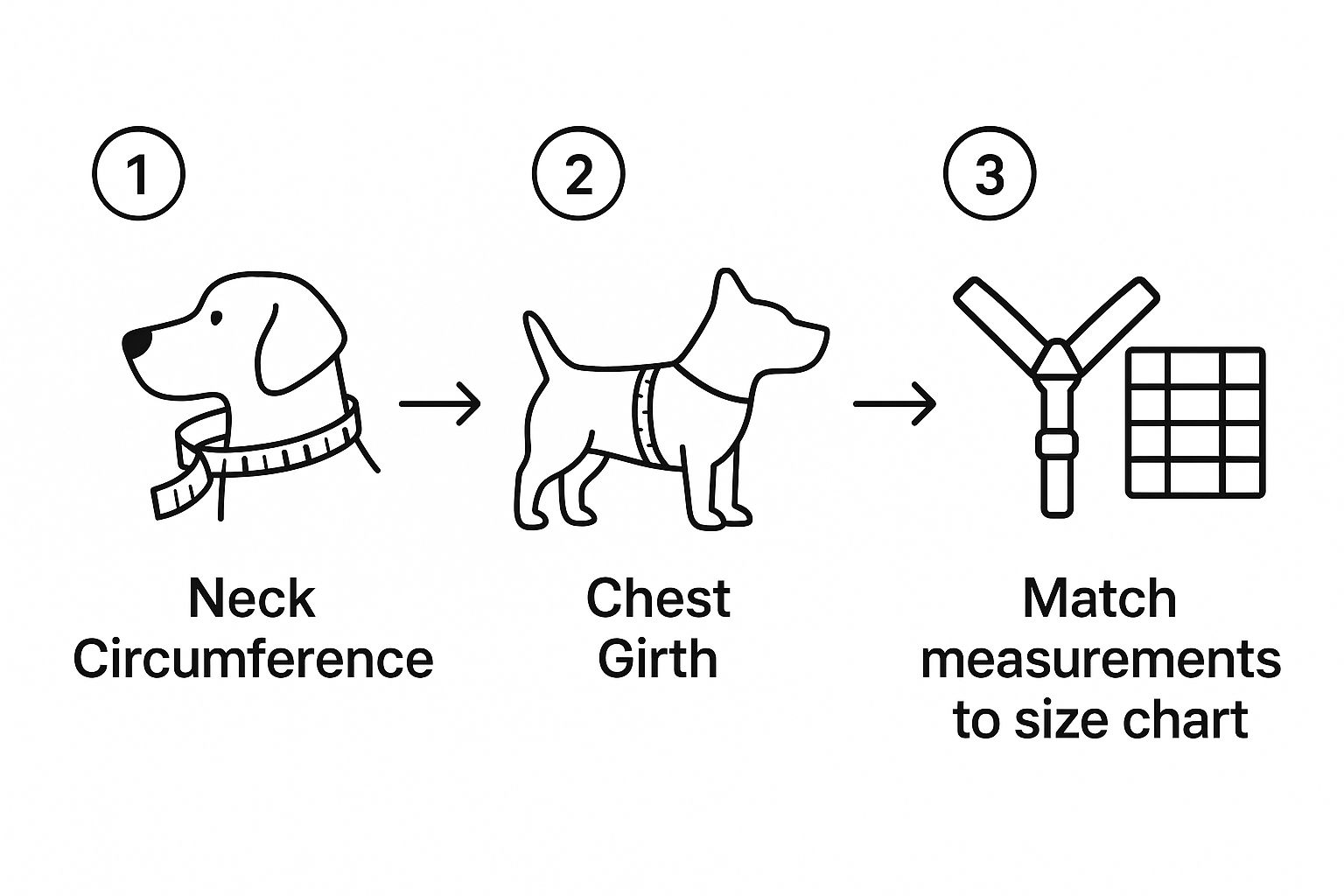
As you can see, it all starts with the chest—the most important part. From there, you’ll get the neck measurement and then you can confidently check it against a size chart.
The All-Important Chest Girth
If you get one measurement right, make it this one. The chest girth is the circumference of the widest part of your dog’s ribcage, located just behind their front legs.
So many people make the mistake of measuring right up in the dog’s “armpits,” but that’s too far forward. To find the sweet spot, feel for their front legs and then slide your hand back a few inches—maybe a full hand’s width on a big dog. This ensures the harness straps won’t rub or get in the way of their shoulder movement.
Now, wrap your soft tape measure around this part of their chest. You want it to be snug, but not tight. If you have a fluffy dog, gently press down so the tape is measuring their body, not just their fur.
Nailing the Lower Neck Measurement
Next up is the neck, but this isn’t where a regular collar would sit. For a harness, you need to measure much lower down, where the harness straps will actually rest across their upper chest and shoulders.
Feel for the top of your dog’s breastbone, right at the base of their neck. Drape the tape measure from that point, up and around their shoulders, mimicking where the neck straps of a Y-shaped harness would naturally sit. This spot is always lower and broader than their actual neck.
To make this even easier, here’s a quick reference guide that pulls together the key points for each measurement.
Harness Measurement Quick Reference Guide
| Measurement Area | Where to Measure | Pro Tip for Accuracy |
|---|---|---|
| Chest Girth | The widest part of your dog’s ribcage, a few inches behind the front legs. | For dogs with thick coats, part the fur so the tape measure rests snugly against their actual body. |
| Lower Neck | From the top of the breastbone, loop the tape up and around the base of the neck/shoulders. | Don’t measure high up where a collar sits. A harness rests much lower and wider. |
Remember, these tips are born from years of fitting harnesses on all shapes and sizes. A little extra care here saves you from the headache of returns later on.
The Two-Finger Rule: Your Final Fit Check
After you’ve got the harness, there’s one last test. You should always be able to slide two flat fingers comfortably between any strap and your dog’s body. This is the gold standard—snug enough to be secure, but loose enough that it won’t chafe or restrict their movement.
Getting these details right can completely change your dog’s comfort and safety. For instance, a tiny Chihuahua might have a neck girth of 8-12 inches and a chest of 12-16 inches, whereas a big German Shepherd could need a harness that accommodates an 18-26 inch neck and a 26-37 inch chest. A loose harness is an escape risk, and a tight one is a health risk. You can dig into more harness sizing and safety data to see just how critical a good fit is.
Making Sense of Sizing Charts and Picking the Right Harness
So, you’ve got your dog’s measurements handy and you’re ready to find that perfect harness. As you start looking, you’ll probably notice something frustrating right away: a “Medium” from one company is a “Large” from another. This isn’t a mistake—it’s just how the pet supply industry works. There’s no universal sizing standard, so never, ever assume your dog is the same size across different brands.
The trick is to completely ignore the letters (S, M, L, XL) and focus only on the numbers. Every brand provides a sizing chart with measurement ranges in inches or centimeters. Your dog’s specific measurements are your single source of truth here.
Why the Chest Girth Is Your Most Important Number
While both measurements matter, the chest girth is the most critical number for a safe, comfortable fit. This measurement ensures the harness stays put and prevents your dog from wiggling backward out of it—a scary thought for any owner.
If you find your dog is between sizes—say, their neck fits a Medium but their chest needs a Large—always go with the size that fits the chest. You can almost always tighten an adjustable neck strap, but you can’t magically add more room to a chest strap that’s too snug.
Think of the chest girth as the anchor point for the entire fit. It’s what keeps the harness secure without restricting your dog’s movement, making it the most important measurement on any sizing chart.
This growing demand for a perfect fit is a big deal. The market for dog collars, leashes, and harnesses was valued at a massive USD 5.47 billion in 2023, and a huge chunk of that is from owners using guides just like this one to match their dog measurements for a harness. You can dive deeper into these dog accessory market trends to see just how much people care about getting the size right.
Let’s walk through a real-world example. Say you have a French Bulldog with a 23-inch chest. You’re looking at two different brands:
- Brand A’s Chart:
- Medium: 20-22 inches
- Large: 23-26 inches
- Brand B’s Chart:
- Medium: 21-24 inches
- Large: 25-28 inches
With Brand A, you’d need a Large. But for Brand B, the Medium is the perfect fit. This is exactly why you have to consult the chart for every single harness you consider, including when you’re browsing our own curated collection of collars, leashes, and harnesses.
Getting the Final Fit Just Right
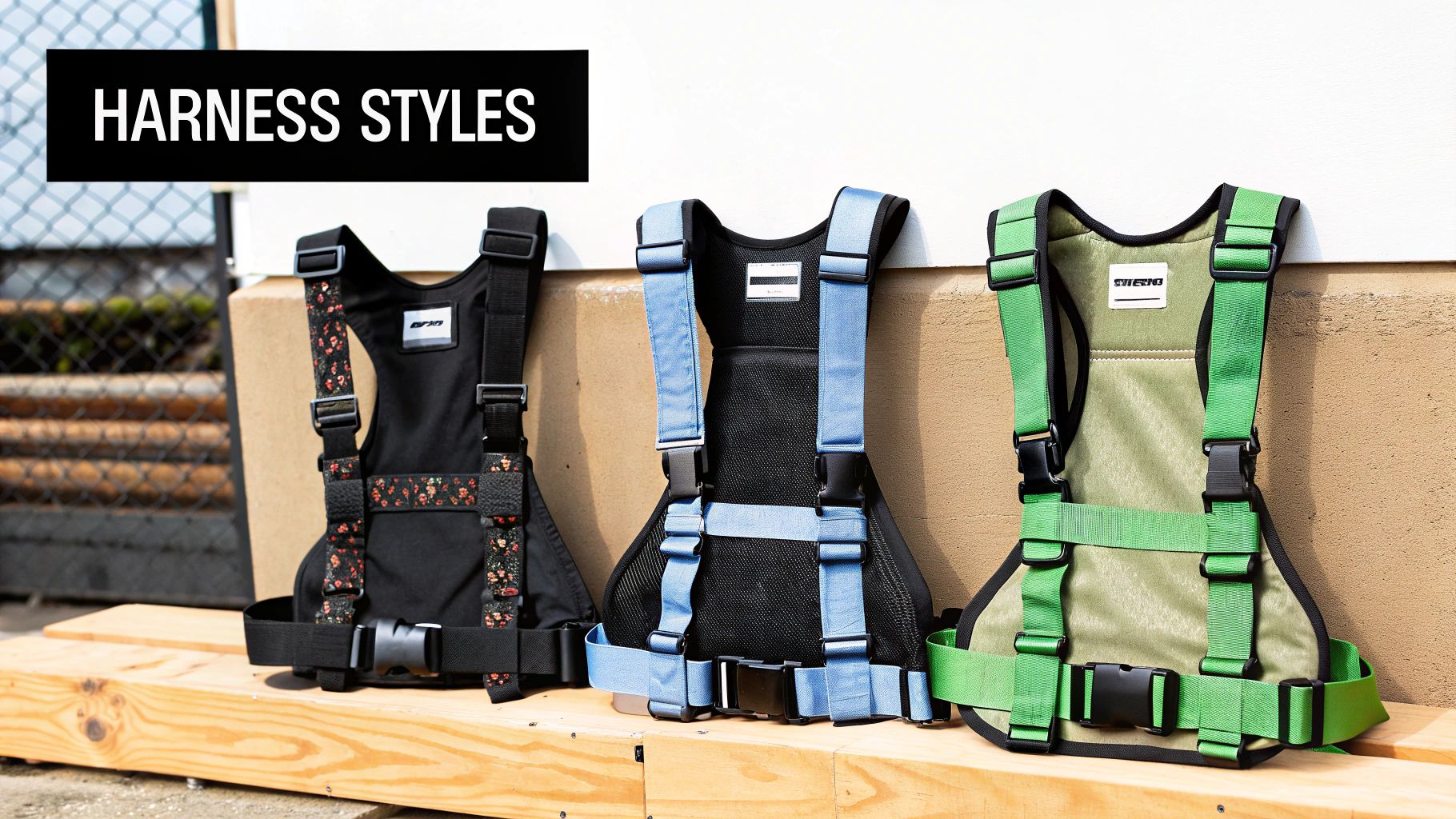
You’ve done the hard work of getting your dog measurements for a harness, and the new gear is finally here. This next part is the most critical step—the final fitting. It’s tempting to just clip it on and go, but spending a few extra minutes on adjustments now saves you from a world of discomfort and potential safety issues down the road.
Before you even try to put it on your dog, loosen all the adjustable straps. This makes it much easier to slip the harness over their head and into position without a struggle. Once it’s on, start with the neck straps, getting them to sit comfortably low on the shoulders and across the chest, well clear of the throat. Then you can move on to securing the belly or girth strap.
The Two-Finger Rule and Other Key Checks
This is a classic for a reason. The two-finger rule is your go-to test for a perfect fit. You should be able to slide two fingers snugly—not too tight, not too loose—between your dog’s body and any part of the harness. This is the sweet spot between secure and restrictive.
Once you think you have it right, run through this quick checklist:
- Check the Shoulders: The harness shouldn’t pinch or sit directly over the shoulder blades. You want your dog to have a full, natural range of motion when they walk or run.
- Mind the “Armpits”: Chafing here is a common and painful problem. Ensure the belly strap sits a good distance behind the front legs—about a hand’s width for a medium or large dog—to prevent rubbing.
- Look for Shifting: Ask your dog to walk a few paces. Does the harness stay relatively centered, or does it twist and slide all over their back? A little movement is fine, but excessive rotation means it’s too loose.
A well-adjusted harness is a partnership between security and comfort. It should feel like a part of your dog, moving with them, not against them.
Pay attention to your dog’s reaction. Are they moving with their usual happy gait, or do they seem uncomfortable or hesitant? A high-quality tactical dog harness that’s fitted correctly should feel so natural that your dog barely even notices it’s there.
Navigating Common Harness Sizing Puzzles
Even when you follow the steps perfectly, you can still run into a few tricky spots when sizing up your dog. Let’s walk through some of the most common questions I hear from fellow dog owners, so you can feel 100% confident you’re making the right call.
One of the biggest hang-ups? That moment your dog’s numbers fall smack-dab between two sizes on the chart. It’s a classic problem, but the answer is usually pretty simple.
What Do I Do If My Dog Is Between Sizes?
When your dog is on the edge, the rule of thumb is to go with the larger size. Just about every good harness has adjustable straps, giving you plenty of room to tighten things up for a snug, secure fit. You can almost always make a slightly-too-big harness work.
On the other hand, a harness that’s too small is a non-starter. It’s not just useless; it can be dangerous by restricting your dog’s breathing and movement. Always let the chest girth measurement be your guide. If that number pushes your dog into the next size bracket, that’s the one you should choose.
When in doubt, size up. You can always tighten an adjustable strap, but you can’t magically add more length to one that’s already at its limit.
How Can I Get an Accurate Measurement on a Fluffy Dog?
This is a big one for anyone with a Golden Retriever, a Samoyed, or any long-haired, double-coated breed. Measuring on top of all that fluff will throw your numbers way off. The trick is to measure the dog, not the fur.
As you wrap the measuring tape around their chest or neck, you’ll need to gently compress the fur. The goal is to get the tape snug against their actual body, mimicking where the harness straps will lie. I find it helps to part the fur with my fingers to get the tape measure right down near the skin. This will give you a much more reliable measurement.
Should I Buy a Big Harness for My Puppy to Grow Into?
I get the logic—you want to save a few bucks. But buying a harness for a puppy to “grow into” is a major safety hazard. Puppies have a knack for wiggling out of things, and a loose, oversized harness is practically an open invitation for an escape.
The much safer route is to get an inexpensive, highly adjustable harness that fits them right now. You’ll need to measure them every few weeks during those big growth spurts and adjust accordingly. Once they’re close to their full adult size (usually somewhere between 10 to 18 months), that’s the time to invest in their “forever” harness.
Finding the right gear is a journey, and at Ur Pet Store, we’re here to make it easier. Explore our collection of high-quality, adjustable harnesses designed for a perfect fit at https://urpetstore.com.



